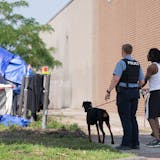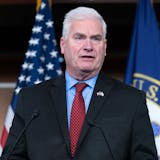In the shadows of a concrete underpass, Jesse Wendt and Nancy Wolf peered out from under a pile of blankets at the first gleam of a December dawn obscured by whirling snow.
It was 14 degrees without the windchill, and the couple was about to launch into their elaborate morning ritual. First, they would survey the surrounding pavement to see if any of their belongings had been stolen overnight. Then, amid the din of rush-hour traffic, they would meticulously load a portable oven, eight blankets, a thin shag carpet, bags of clothing and a thick stick for protection into two shopping carts.
By 9 a.m., the couple and their mini-caravan had set off down a busy road in Richfield in search of a hot cup of coffee and refuge from the cold. Dozens of cars passed by, and many people slowed to gawk at the hooded figures pushing their carts. No one offered any help until an older man pulled over and handed Wendt a pair of new snow boots. "This means so much," said Wendt, 43, after the man left. "Because there are times when we feel invisible."
While they represent less than a quarter of Minnesota's homeless population, people who sleep outside in the elements and not in shelters pose a persistent challenge.
Many drift from bridge to bridge and park to park, risking frostbite and death, to avoid being seen and to stay out of harm's way. Some, like Wendt and Wolf, prefer the independence of the streets to the emergency shelter system and its bevy of rules. A combination of other factors — including escalating street violence, lack of affordable apartments and a resurgence of COVID-19 — is pushing more of the "unsheltered" to the margins of the Twin Cities metro area, where they are further cut off from support networks, say homeless outreach agencies.
But there are signs of hope for this hard-to-reach population. Across Minnesota, county agencies and nonprofits that do outreach are increasingly embracing a "housing first" strategy, in which everyone who is identified as homeless is offered a stable home without preconditions such as sobriety or employment. The strategy is based on the simple yet redefining idea that until a person's housing is taken care of, other issues such as substance abuse, mental health and work status cannot be adequately addressed.
In Hennepin County, with the state's largest homeless population at 3,000, officials are taking this model to the streets.
Over the past month, they have have begun deploying mobile teams of caseworkers — 30 in total — to parks, highway underpasses, transit stations, shelters and other spaces to assess immediate needs and remove barriers to stable housing. The outreach effort marks a significant shift: In the past, the emergency shelter system was the primary path to housing for individuals and families experiencing homelessness. As a result, people who avoided the shelters and primarily slept outside did not have the same access to services.

